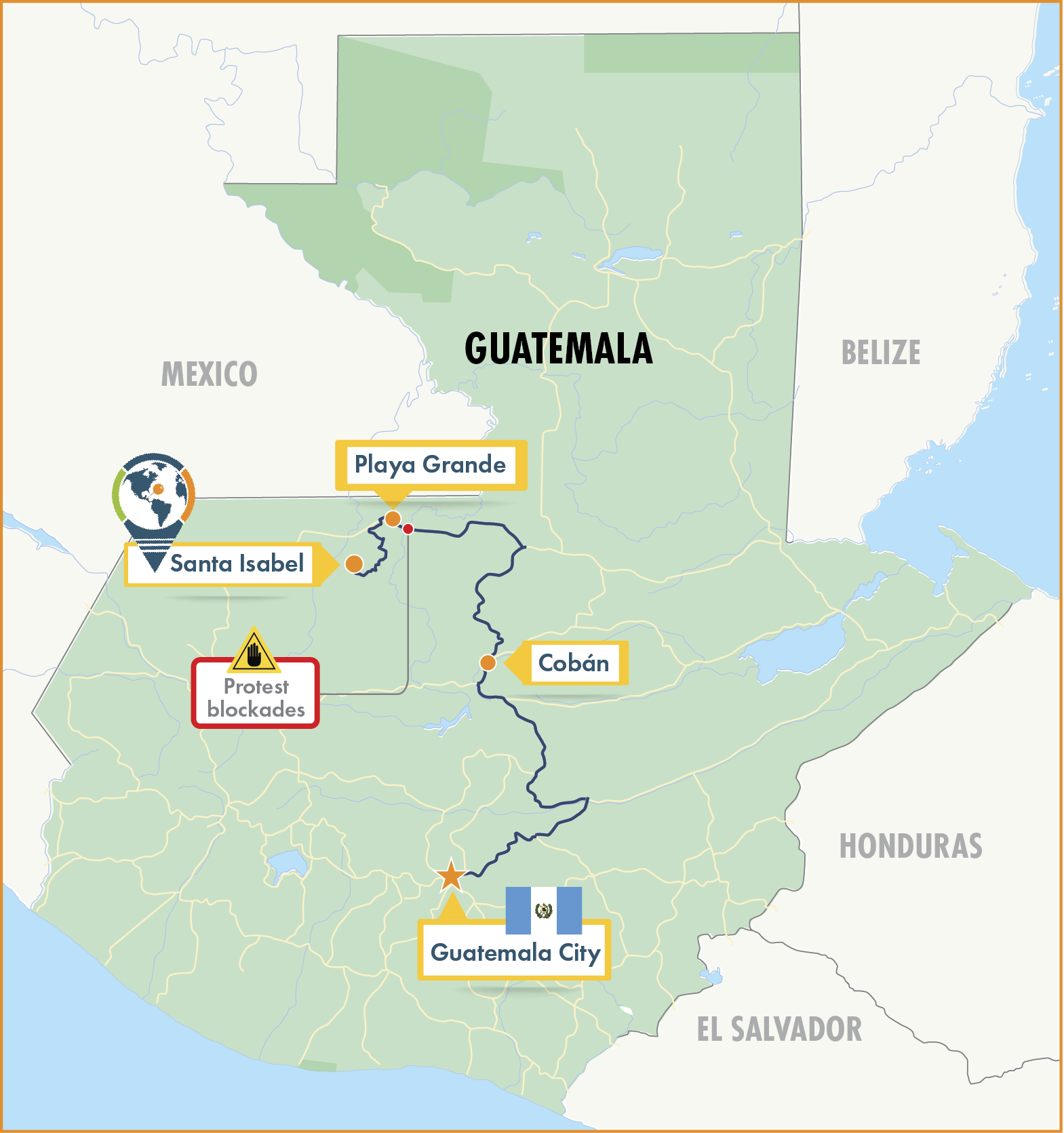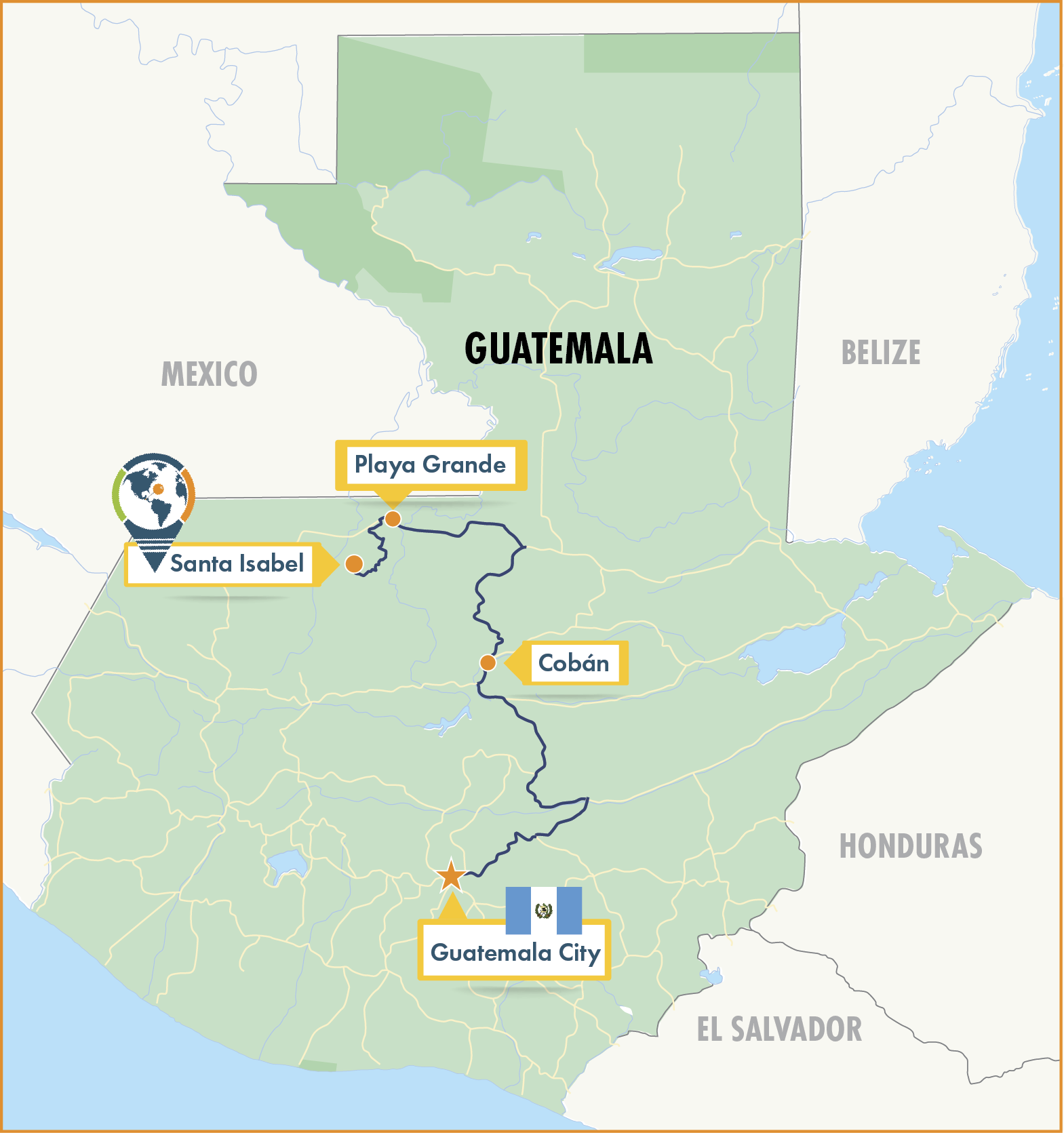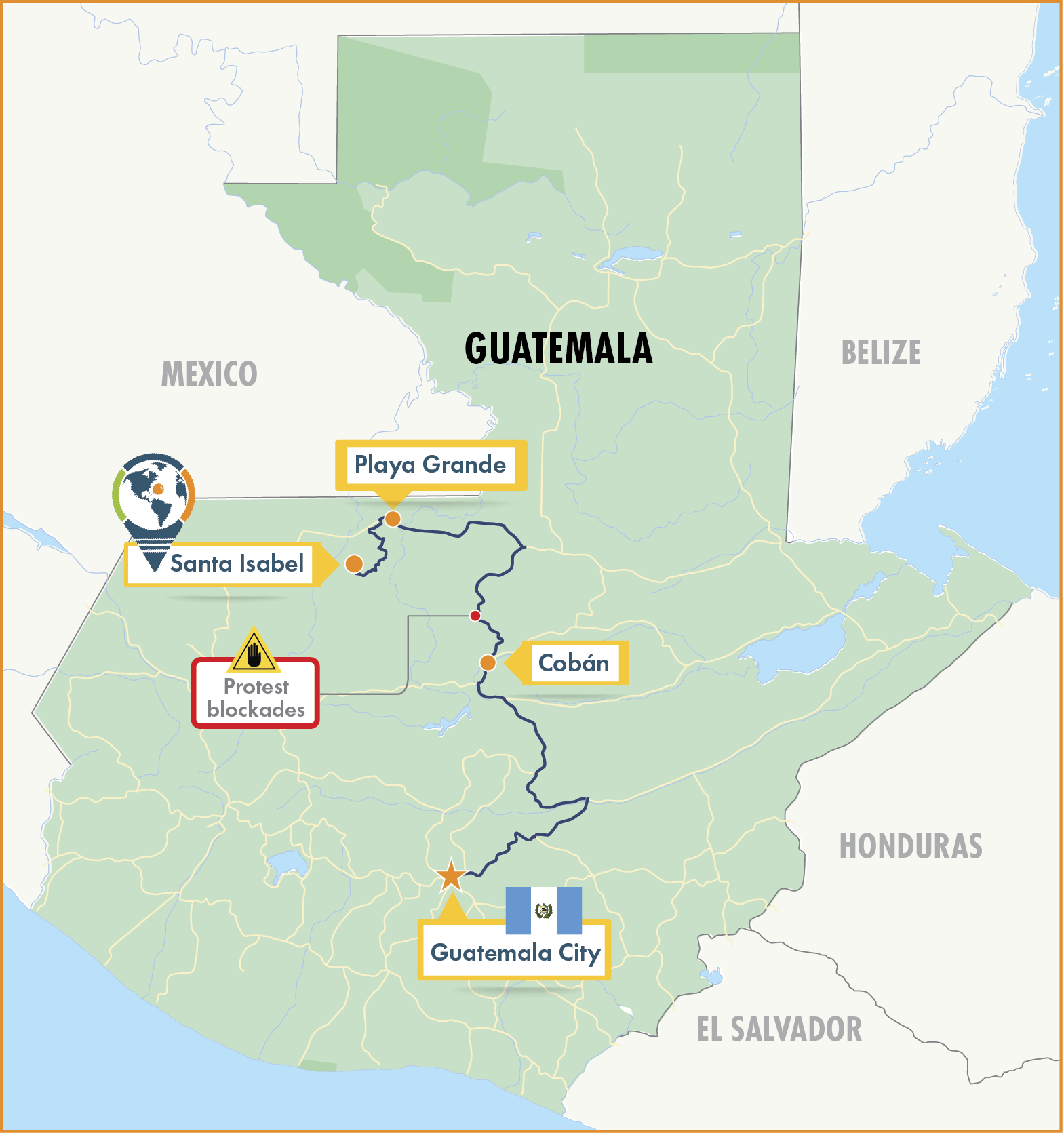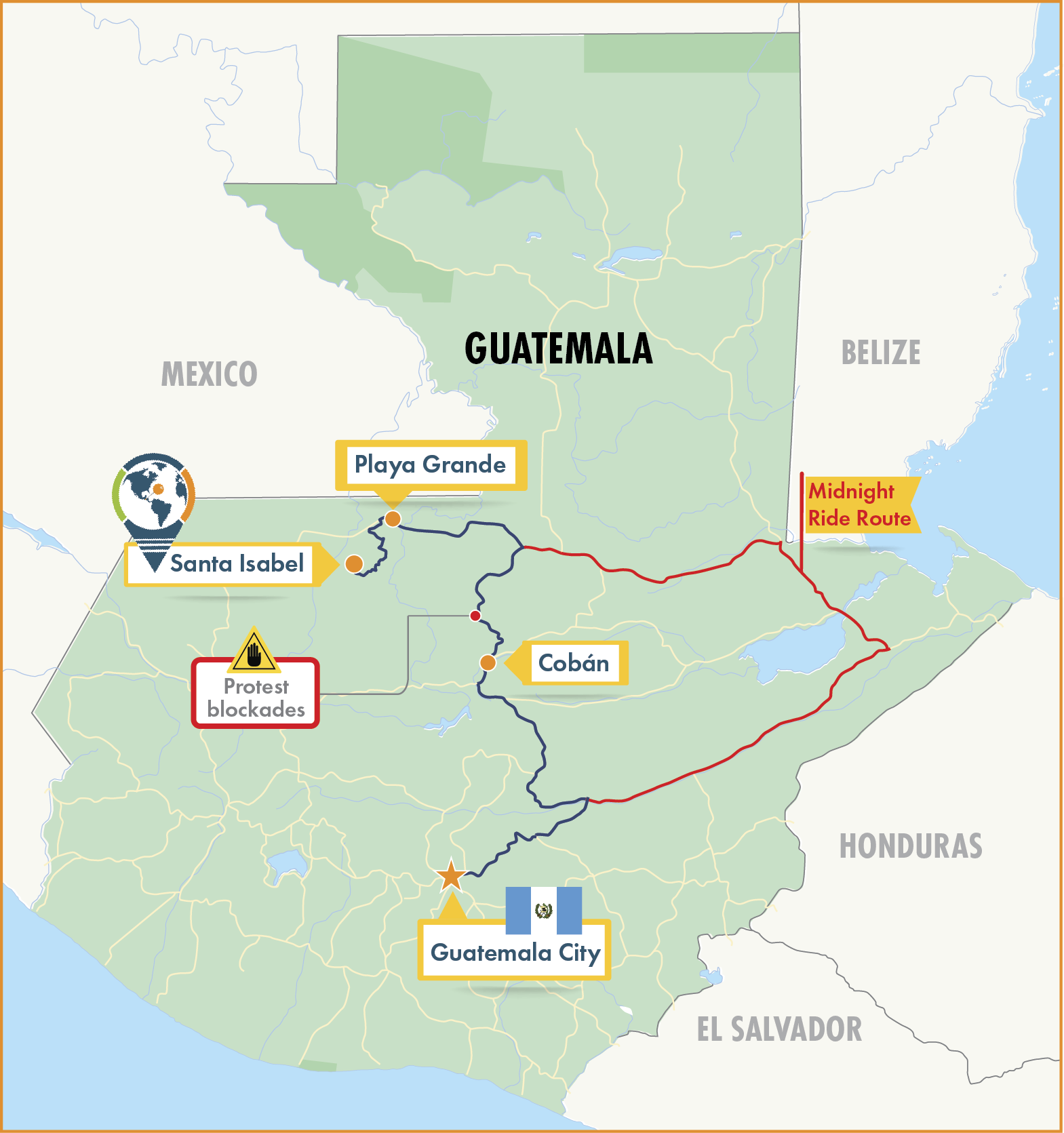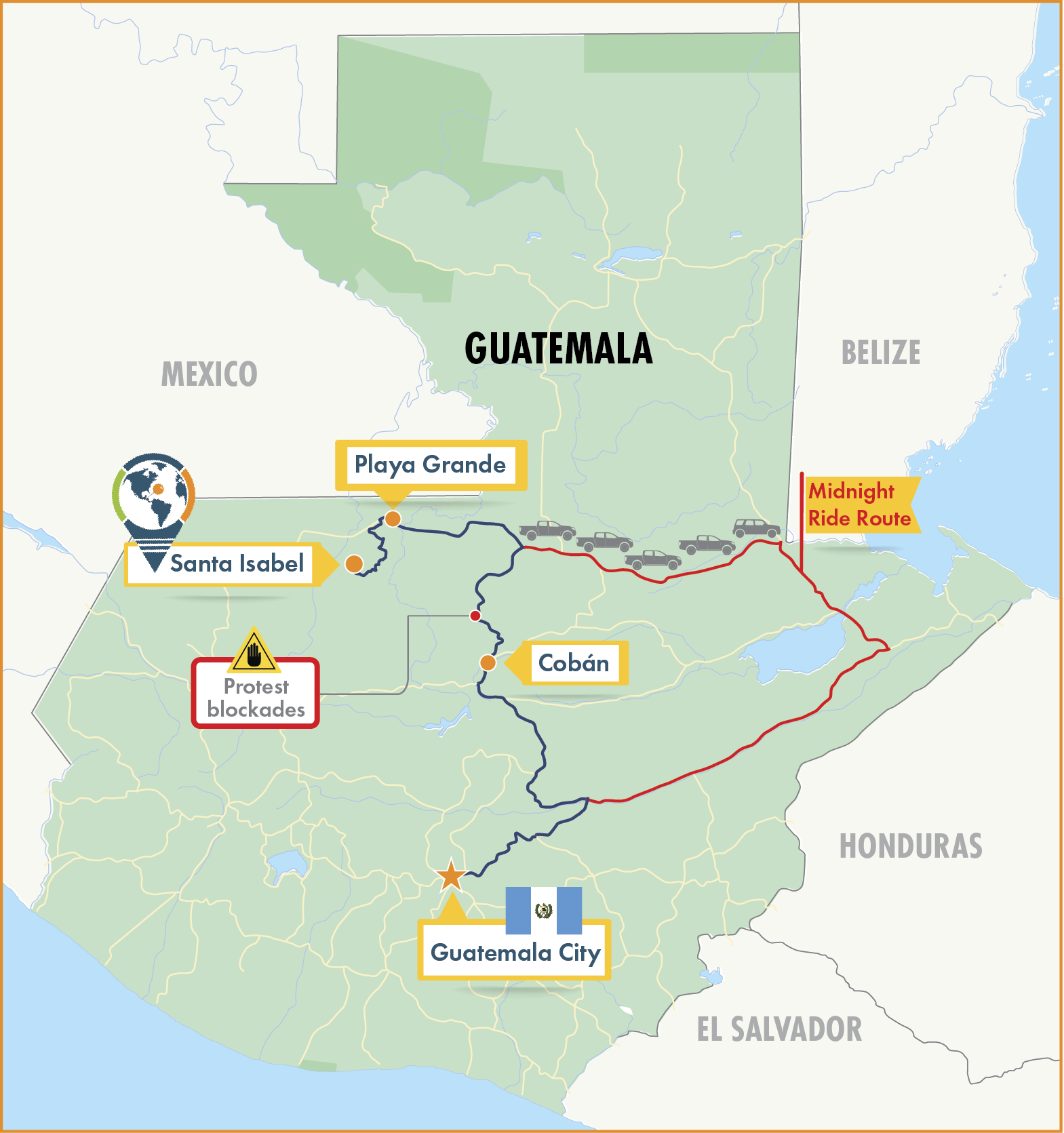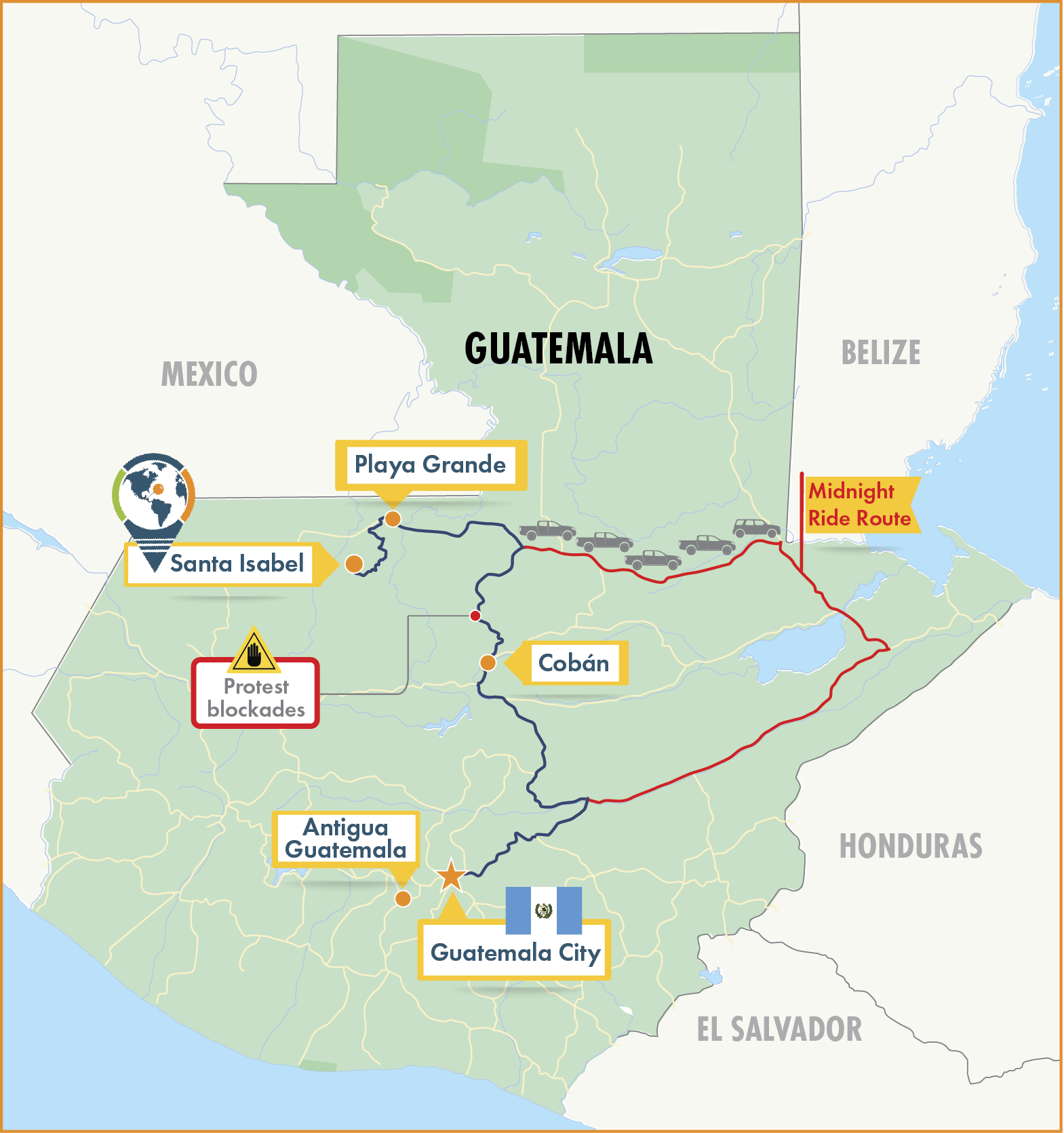Bringing the Light
to Rural Guatemala
SMECO line workers join
Mid-Atlantic colleagues
to electrify a remote village
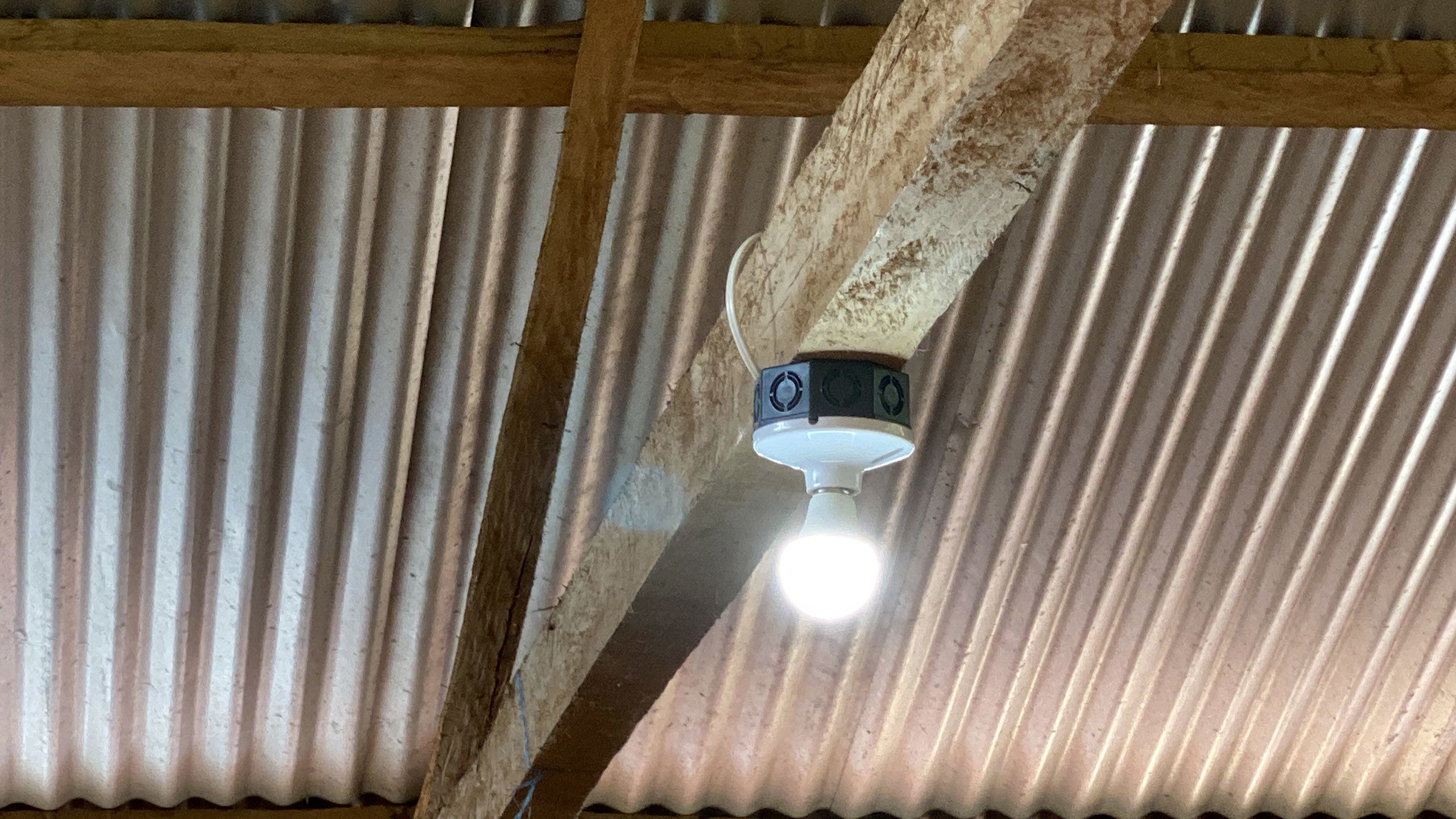

Through the hard work of two SMECO line workers, and more than a dozen others from cooperatives in Virginia and Maryland, the village of Santa Isabel in Guatemala has electric service for the first time. The team endured muggy weather in October for two weeks while connecting 100 houses to that nation’s grid and installing lights and outlets. During their stay, the workers formed a bond with Santa Isabel’s children, a generation that will now grow up with electricity.
A village ready for power
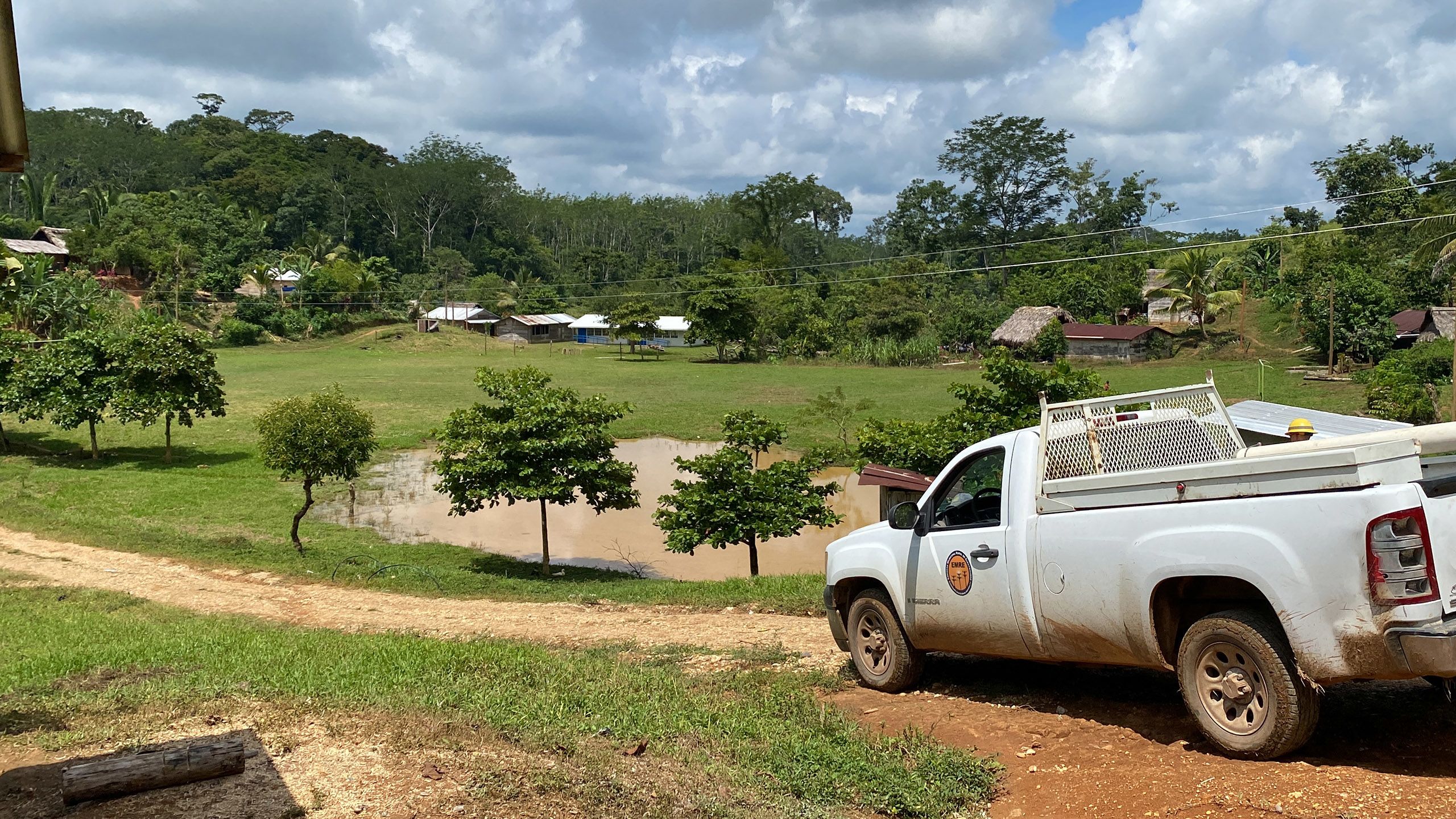
In the rural stretches of north-central Guatemala, Santa Isabel may not appear on a map to be isolated, being only 30 miles from the nearest city. Traveling there from the Ixcán municipal capital of Playa Grande, however, requires a drive of almost an hour and a half. Much of the road is paved with good-sized stones that make for a bumpy ride. The hills must be ascended at extremely slow speeds, and descending requires coasting with a sure foot on the brake. In some sections, the opposite side of the road offers the only tolerable route. The other vehicles traveling there, besides motorcycles, are pickup trucks with large metal cages in the beds, enabling several people to ride standing up while holding on to the bars.
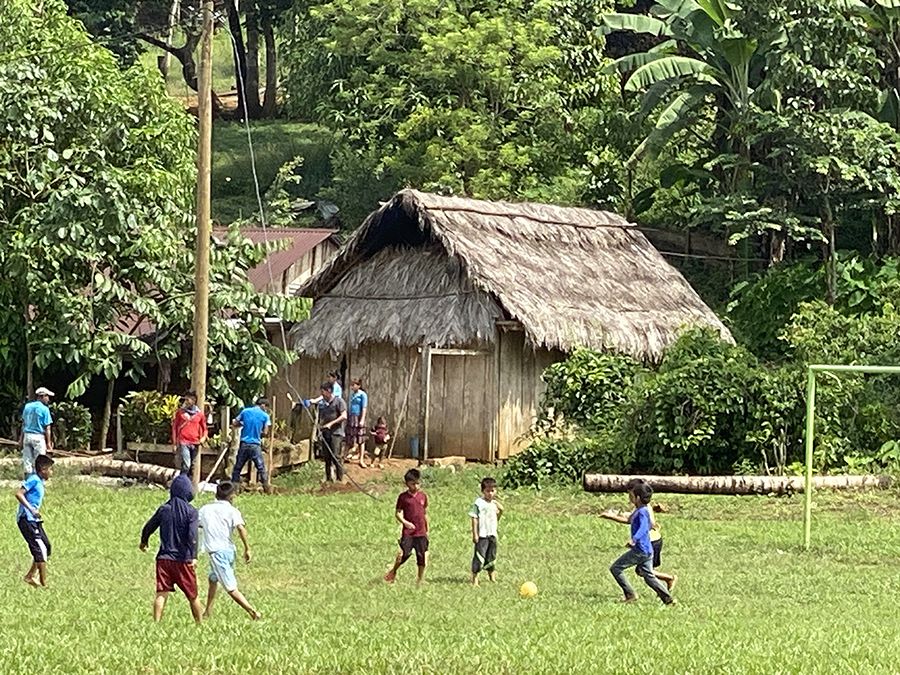
Santa Isabel’s 500 residents, from the Q’eqchi’ Maya people, live mostly in wooden shacks with roofs of either corrugated metal or thatch. Families cook their meals over wood fires in indoor kitchens. They had waited 15 years for electric service to come. For some time, they had relied on tiny solar panels that powered a light bulb or a radio or a mobile phone charger, or in a couple of cases, a television and a DVD player. At the schoolhouse, a large pole-mounted solar panel provides power for several outlets, including one for a public-address system.
The local Guatemalan utility, Empreza Municipal Rural de Electricidad (EMRE), had mounted more than 5 miles of utility poles in the village and along the road leading to Santa María Dolores, the nearest town on the grid. The primary poles still needed wires and insulators, the secondary poles required transformers, and short rectangular poles of tamarind wood or concrete needed meters and conduit for the service connections. The homes themselves would also have to be wired for power. Nine electric cooperatives in Virginia and Maryland, including SMECO, provided 16 line workers and two coordinators to help finish the job. It was an intensive task that meant climbing poles instead of using bucket trucks, complicated by unseasonably hot and humid weather that saw temperatures rise well into the 90s.
Each morning when the Americans would arrive, a village official would take to the microphone to announce the workers’ arrival over the PA, sometimes even asking residents to assist with the electrification work.
Welcome to Guatemala
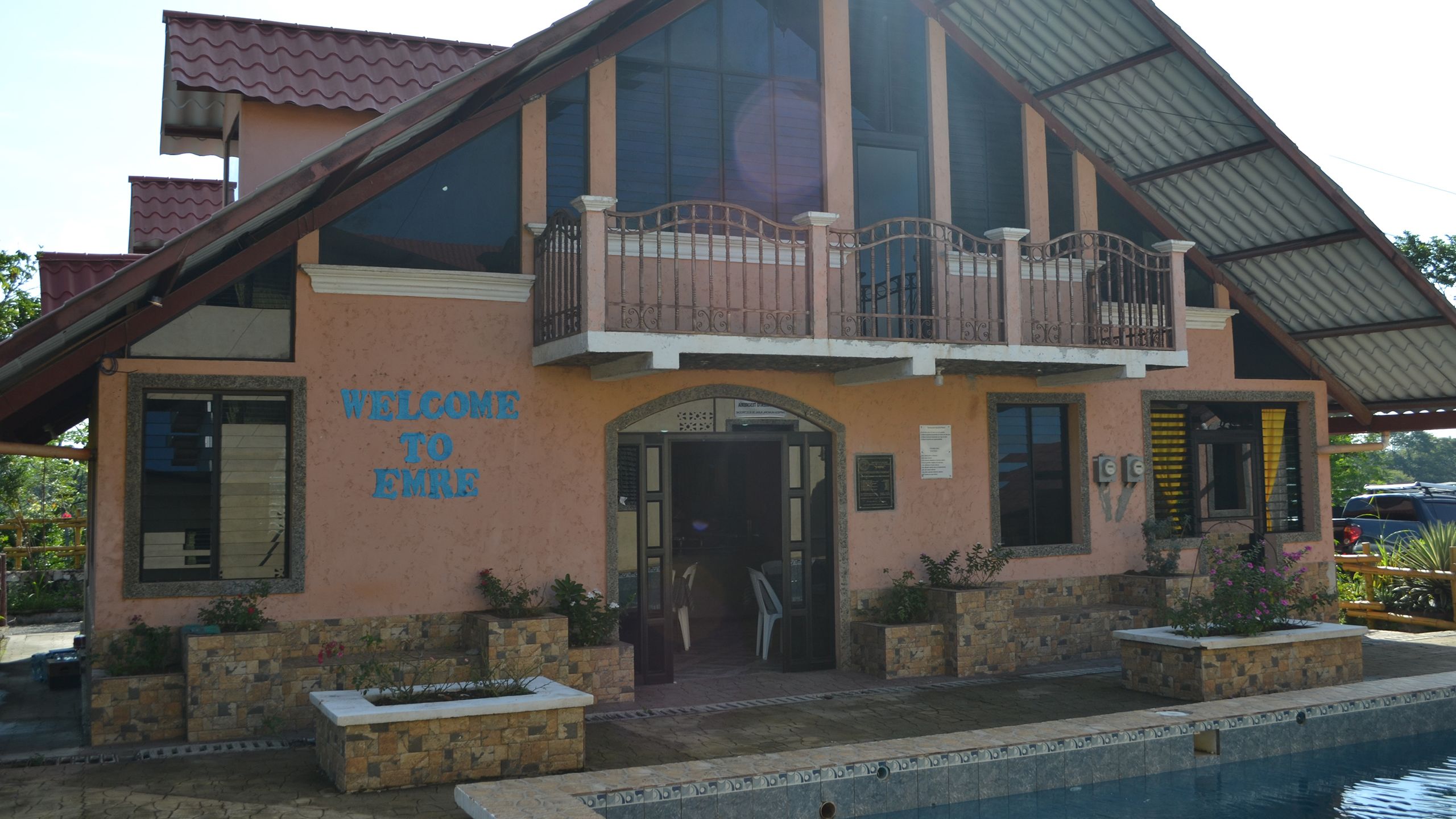
Organizing the electrification mission was the Virginia, Maryland, and Delaware Association of Electric Cooperatives (VMDAEC) with the support of the National Rural Electric Cooperative Association’s (NRECA) international unit, which provided local translators skilled in both Spanish and the Q’eqchi’ language. VMDAEC’s group included three SMECO employees—line workers John Meade and Jared Stern, and communications and web site specialist John Johnston as embedded journalist.
The team landed in a country in political turmoil on October 3. President-elect Bernardo Arévalo had promised to fight corruption, and his supporters were blocking many roads and demanding the resignation of officials accused of plotting against Arévalo taking office. The blockades not only interfered with commercial truck traffic in the country, they also threatened to prevent the VMDAEC team from getting to its destination, but not its commitment to completing the mission.
After the arrival in Guatemala City, the team rented trucks and headed for lunch at an upscale shopping mall, where most stores were identical to any mall in the United States. The restaurant spread the meals out in a feast, as if the line workers were visiting royalty. After eating, the team tied tarps over the tool bags and suitcases in the trucks, as early October in Guatemala is still the rainy season. They spent the first night in a resort near Cobán, several hours north of the capital city.
Getting to the work site
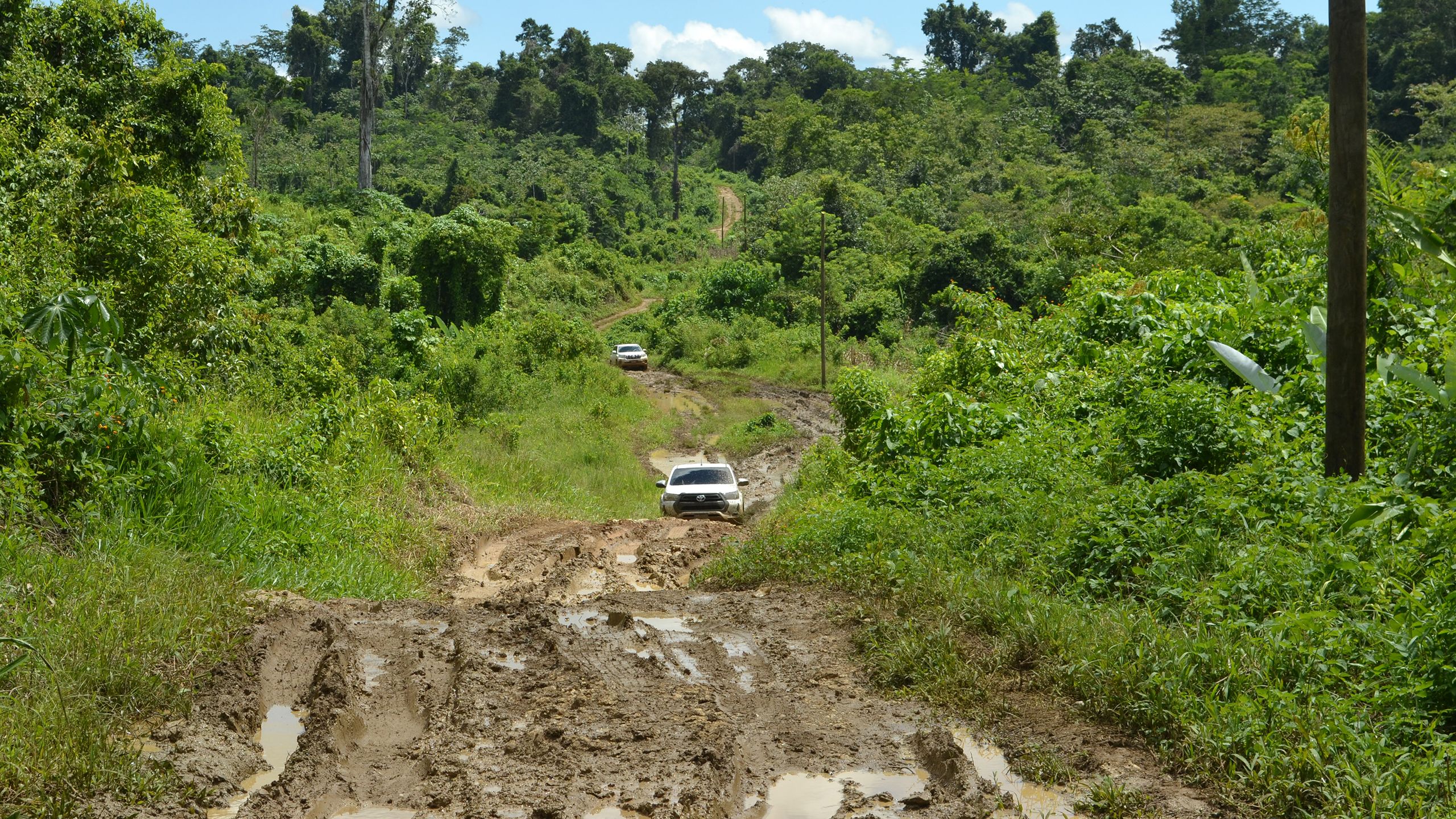
Protesters were blocking a bridge on the road north to Playa Grande the following day, causing a temporary delay for the travelers. After lunch in Cobán, they decided to try their luck and head north, prepared to turn around if the protests made the road impassable. While the caravan was forced to stop twice because of protests and congestion—the second time for at least an hour—they managed to reach their planned destination six hours later.
At 10 p.m., the VMDAEC team finally arrived at the EMRE office in Playa Grande for a quesadilla dinner. EMRE provides a full-service cafeteria and an outdoor pool, as many of its line workers live at the facility during the week. Through the generosity of the utility, the Americans would eat their morning and evening meals at the utility office for almost two weeks, and in the Santa Isabel village, they would eat lunches provided by EMRE.
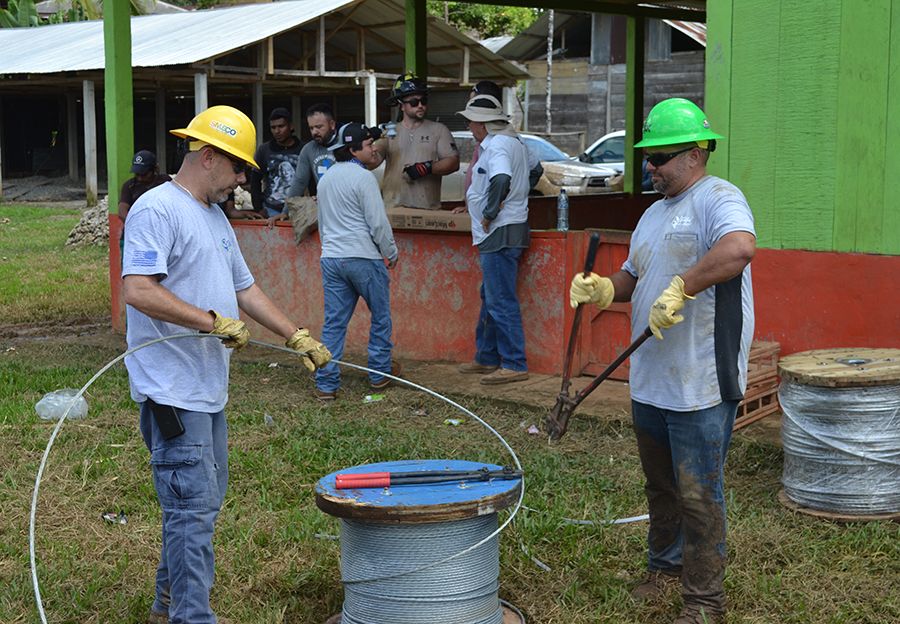
The next morning, October 5, the VMDAEC workers made their first arrival in Santa Isabel to set eyes on the work site. Residents along the road stood outside their homes watching the caravan of trucks drive by. The team, accompanied by an EMRE crew, pulled into the village center and parked next to a school, unloading material for line construction and storing it in the classrooms. Children from the village lined the exterior of the low wall around the school’s courtyard, watching the tall strangers with fascination and perhaps a little trepidation.
After looking over the secondary poles in the town, the American and Guatemalan crews drove along the right-of-way leading to Santa María Dolores. The dirt road was 5 miles of muddy, bumpy agony. Twice during the inspection, trucks became stuck and had to be pulled or pushed free. Stern and other line workers ended up covered in mud while pushing.
The truck carrying the SMECO employees came out of that sloppy mess the cleanest, thanks to Jimmy Contreras, the translator and driver who approached each muddy patch with care.
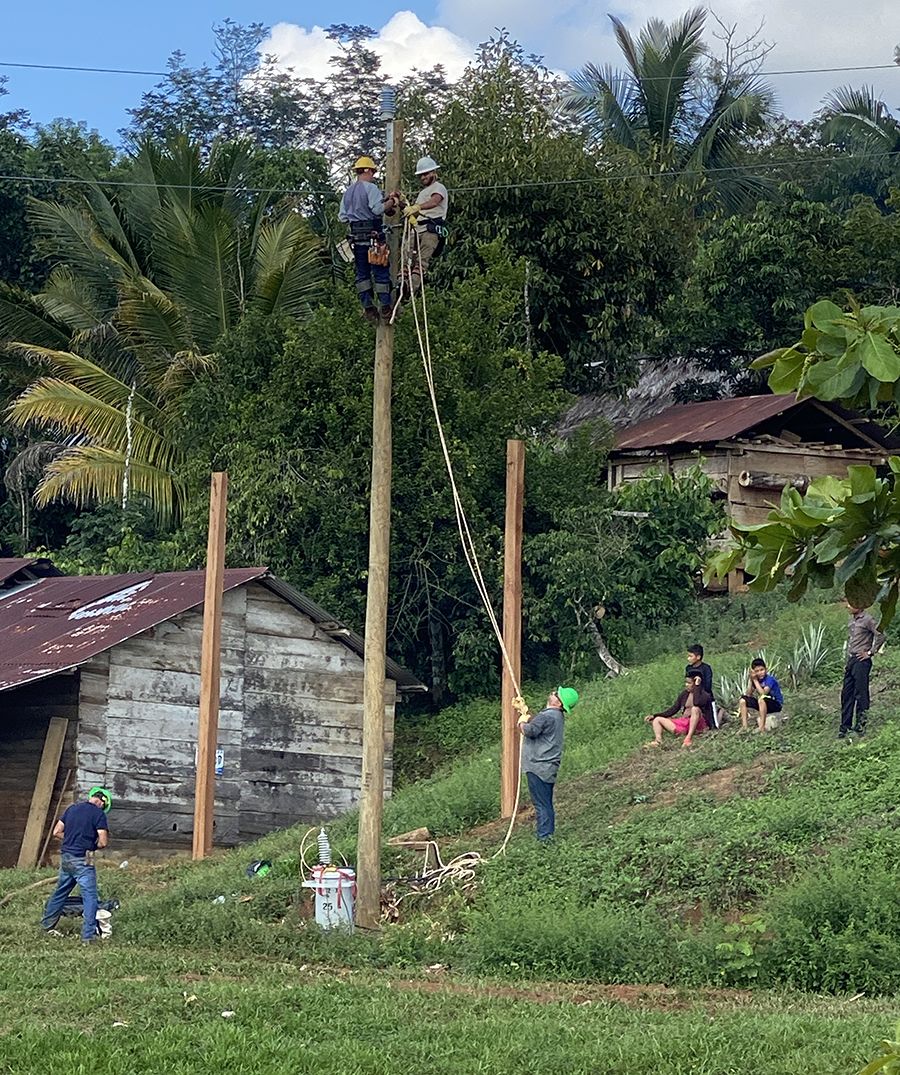
Part of the VMDAEC team drove back down that muddy road for several days to build the primary line, working their way toward the Santa María Dolores connection. Meade and Stern were part of another crew that stayed in the village to work. Most days, they partnered with Casey Butler from Choptank Electric Cooperative and Denny Crockett, a Tangier Island native from A&N Electric Cooperative. This crew worked amongst the houses spread out from the village center. They climbed the secondary poles to attach the wires, and used their pickup trucks to pull ropes to lift the transformers into place. After finishing days later, they joined the other crew on the primary line.
A third crew went inside the houses to install boxes for the lights, outlets, and switches. Each dwelling received two or three interior lights and one exterior light. Willy Alonso, the Q’eqchi’ member of the translation team, accompanied the crew and asked each family where they wanted the lights in their rooms. One 84-year-old man repeatedly pointed with a stick to the spot on the joist where he wanted a light.
Making New Friends
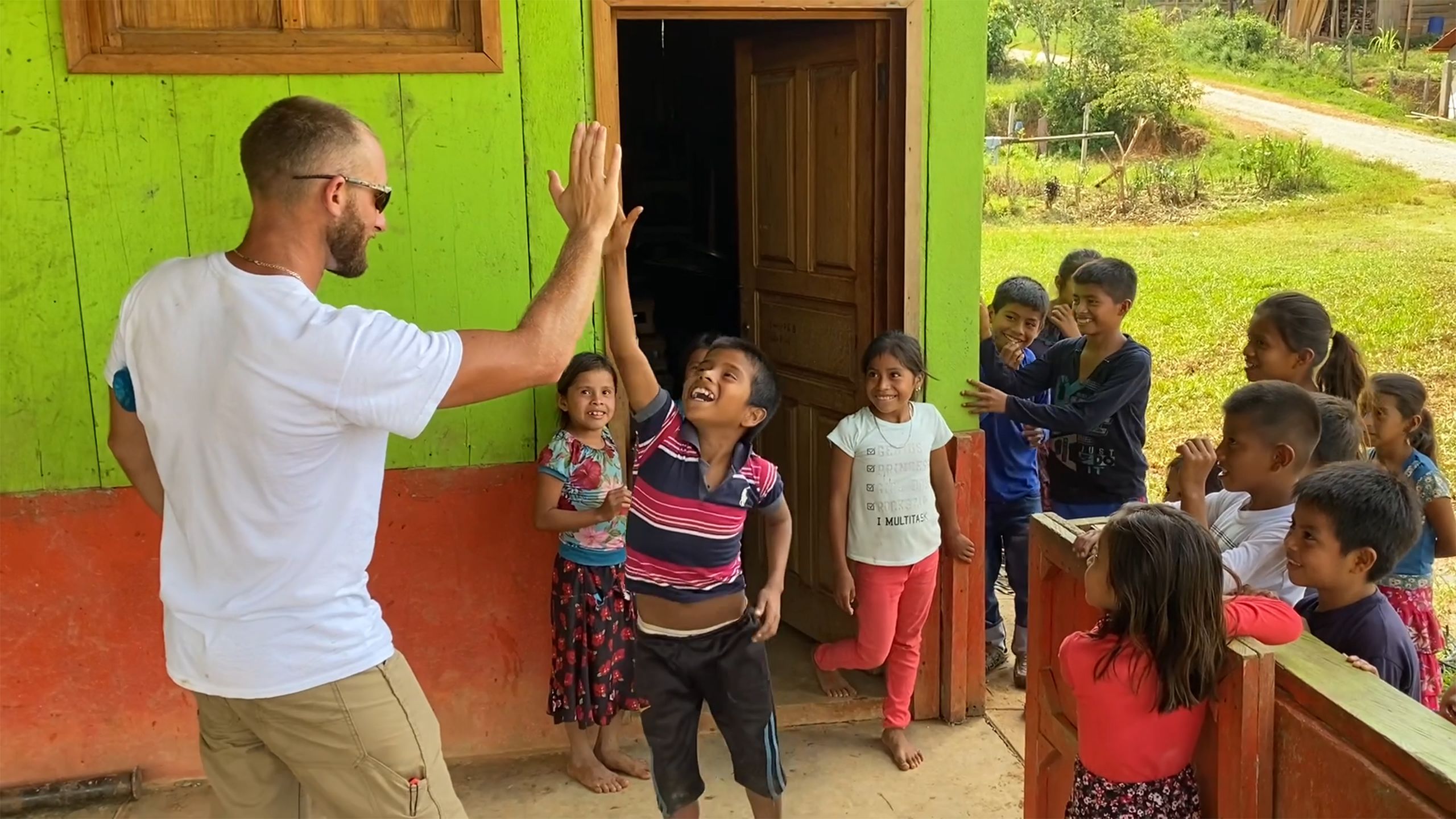
Whenever the line workers were climbing in the village, they had audiences of residents, particularly children. Mark Bandy from Mecklenburg Electric Cooperative overheard the kids hooting at each other, so he repeated the sound. Soon it became a game and a friendly greeting between the Americans and the children.
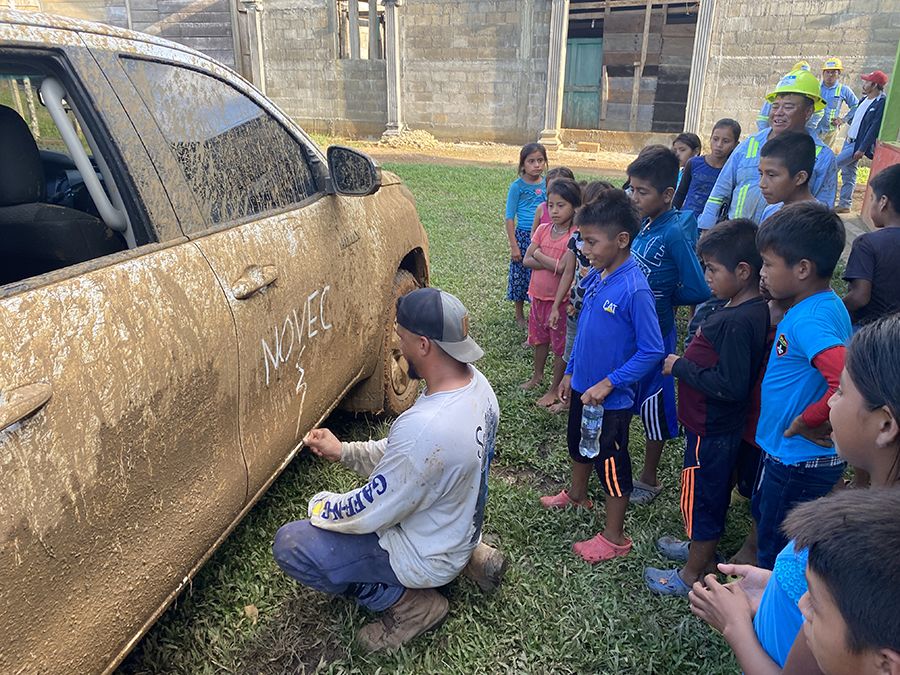
Often after completing work for the day, the line workers would show the kids photos on their phones, join in soccer games, teach them how to high-five, and organize other games for the kids. The Americans spotted some children playing with an empty roll of electrical tape, so they set up two water bottles on the floor and had the children roll a fresh roll of tape between the bottles. Mauricio Paz wrote Northern Virginia Electric Cooperative’s acronym, NOVEC, in the mud on the door of his truck, and then he led the kids in a chant of the word. One afternoon the team wrapped up early and gave the kids gifts of soccer balls, and the school’s courtyard was filled with the sounds of bouncing. The looks and sounds of the children’s joy was worth all the hard work and sweat that the line workers expended on the project.
Adults in the village, eager to see their homes electrified, pitched in to help the operation. They drove grounding rods next to the service poles, sometimes using planks when they couldn’t find hammers. Inside the houses, they loaned wooden ladders to the workers and helped lift wire to the joists. They thanked the Americans by presenting gifts of fresh fruit: oranges, limes, and a large basket of rambutan. The latter is a small tropical fruit whose thick red skin is covered in spines.
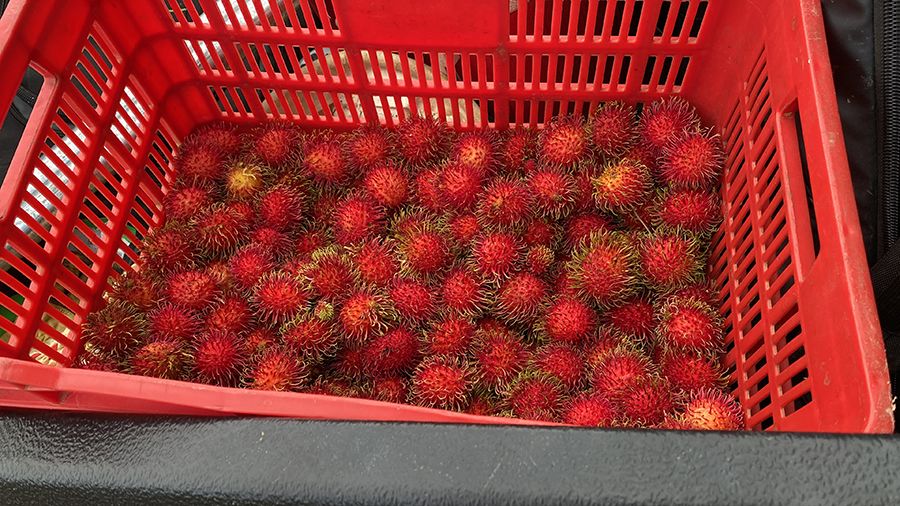
Santa Isabel’s children were also helpful. Occasionally, a worker would drop a wire nut or wire staple when installing interior wiring and a child would pick up the item and return it to the crew members. One girl helped Gena Boarman of Northern Neck Electric Cooperative drive a screw into a service pole to hold the meter. During flights of a drone provided by Sentinel Robotic Solutions, the kids clustered around John Johnston, the aircraft’s operator, and served as spotters. He would ask “¿Dónde está?” (“Where is it?”) and plenty of little fingers would point into the sky at the drone.
The VMDAEC and EMRE teams bonded over the shared profession of line work. Taking one day for a break from the job, they faced each other in a game of soccer, held in a covered facility complete with a play-by-play announcer. The players worked up just as much of a sweat as if they had been working in the village, perhaps more. One evening after dinner, they squared off for arm-wrestling matches at the EMRE shop. “Work hard and play hard” may indeed be a cliché, but where line workers are concerned, that doesn’t change the phrase’s essential truth.
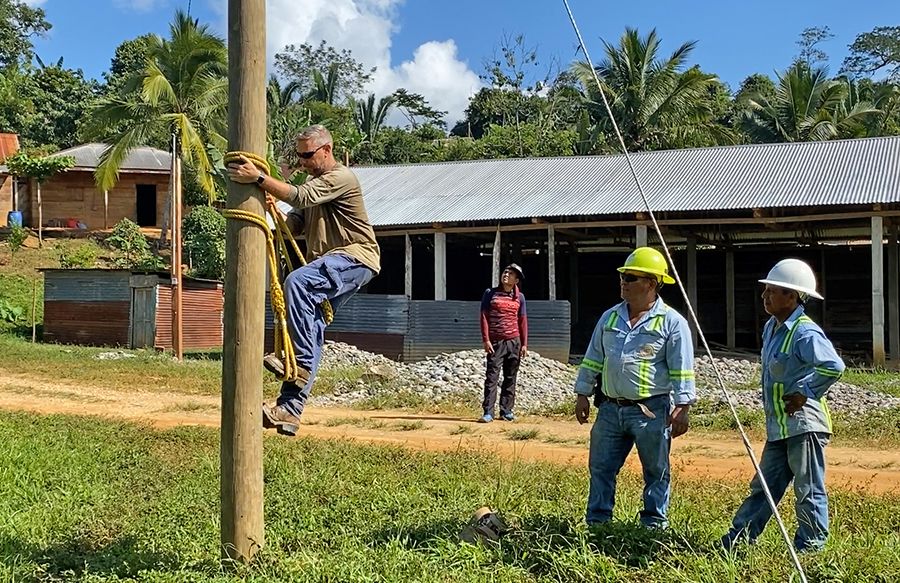
Toward the end of the job, EMRE offered what amounted to apprentice training for the Americans. Instead of a climbing strap and a pair of hooks, a Guatemalan line worker climbs poles using two ropes with loops. One rope is for one foot, and the other rope is for the opposite thigh. In the Santa Isabel village center, several VMDAEC workers used the EMRE ropes to climb a pole to respectable heights. Earlier, one of the EMRE workers, a man named Mendoza, had fun climbing a pole the American way.
A Solar Treat
Santa Isabel had an excellent vantage point for an annular solar eclipse on the morning of October 14. The village had clear skies for the phenomenon. At the height of the eclipse, about 84 percent of the sun was covered, which brought a strange quality to the sunlight, like a filter. In one house, the crescent shadow of the sun was visible on the dirt floor through a small hole in the metal roof. One of the translators, Erick Berganza, pointed out the shadow to the children living in the home and explained how the moon was passing in front of the sun.
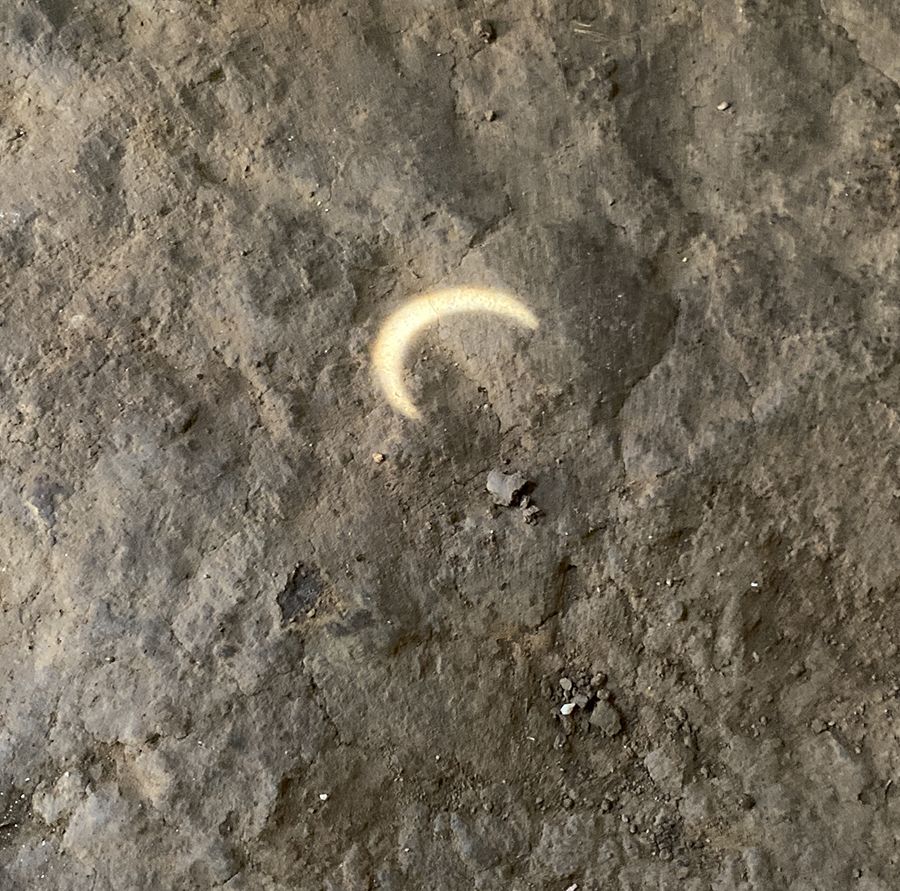
The lights come on
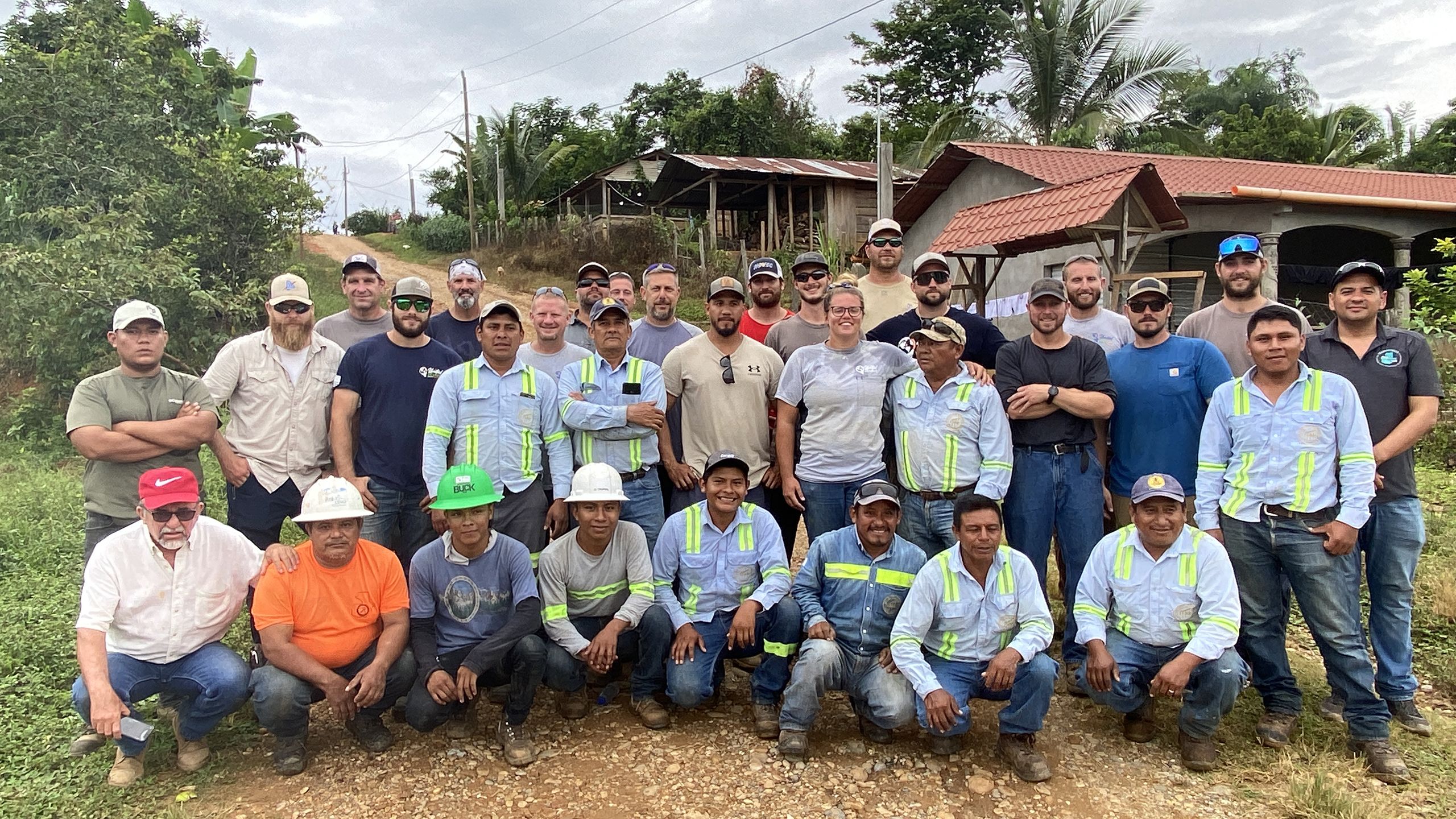
The final day of the project, October 16, marked the welcomed arrival of temperatures in the 70s. At the EMRE shop, VMDAEC workers collected a few used meters to finish the service connections in Santa Isabel. After the team arrived in the village, some of the workers stayed at the soccer field to install dusk-to-dawn lights. The others installed the remaining meters and finished the fixtures and the few remaining outlets. The EMRE workers went to Santa María Dolores and activated the primary line’s fuse shortly before 2 p.m., connecting Santa Isabel to Guatemala’s grid. The village center is in a shallow valley overlooked by houses in either direction of the road. When the electricity came on, one could hear shouts and loud talk from both directions as outside lights on the buildings were lit for the first time. At last, a community that had waited many years for power now had it.
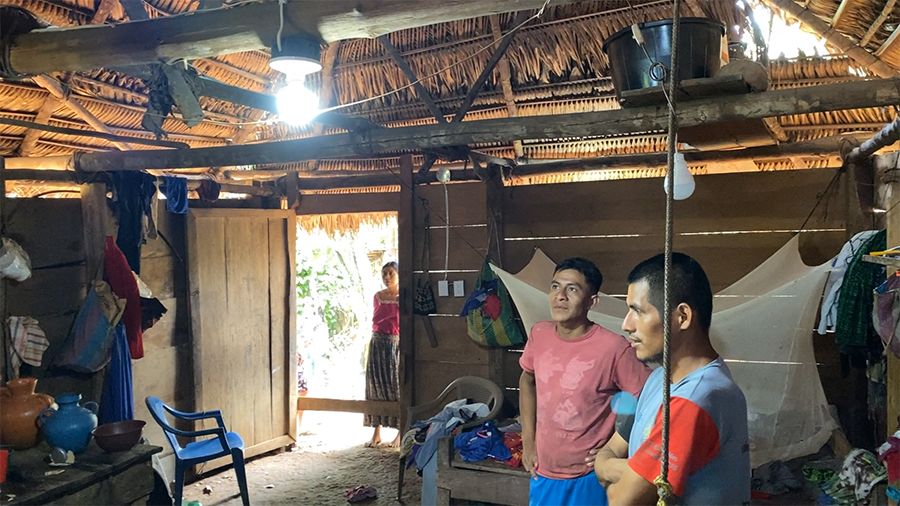
Next came the inspections. The Mid-Atlantic team went from house to house, locating any dwellings where the lights still weren’t on. Often the residents would stand by the road to direct the workers. In a few cases, the fix was as simple as making sure the circuit breakers were placed properly in the electric panel. Residents offered high-fives to the line workers in celebration.
There were many smiles when the full team gathered back in the village center. The rain had held out for almost the entire day, waiting until the Mid-Atlantic team got back to their hotel. The Americans collected cash to present to the EMRE kitchen team as thanks for preparing all the meals. They also gave their EMRE line worker colleagues some of their gear. Dinner that night was hamburgers, potatoes, and ribs, with ice cream bars drizzled in chocolate for dessert. The host utility presented the Americans with EMRE hats, mugs, and work shirts.
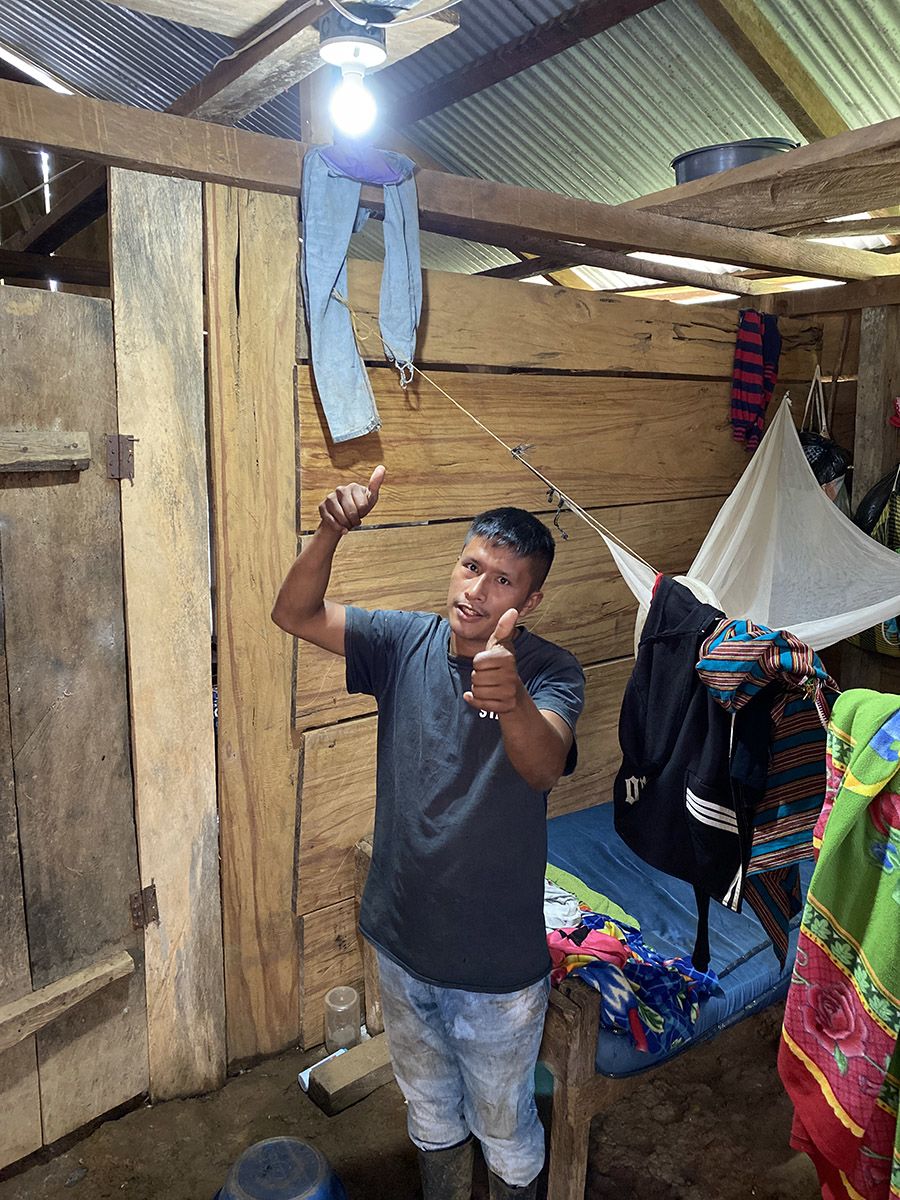
The big bash
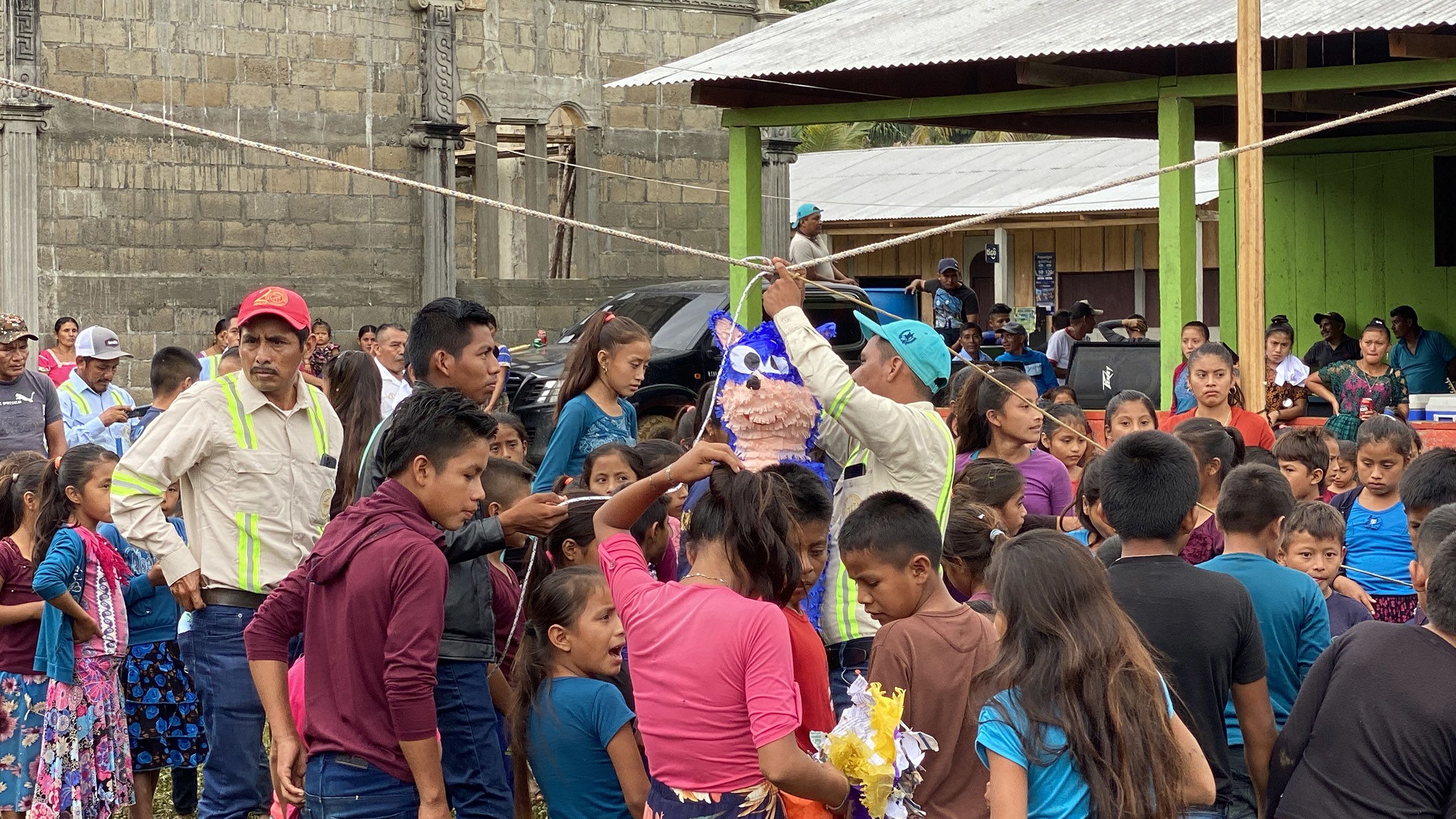
When electricity finally comes to your town, it’s time to celebrate and reflect. The VMDAEC team returned to Santa Isabel one last time on October 17, dressed in EMRE shirts and hats in tribute to their hosts.
The entire town was gathered around the school’s courtyard, the site of so many lunches on work days. EMRE’s board of directors rode a bus to appear at the event. Several dignitaries, including Santa Isabel’s mayor, delivered prayers and gave speeches thanking everyone and describing what electricity means for the tiny village. All the team members—VMDAEC, EMRE, NRECA International, local electricians, and men from Santa Isabel—received medals and plaques.
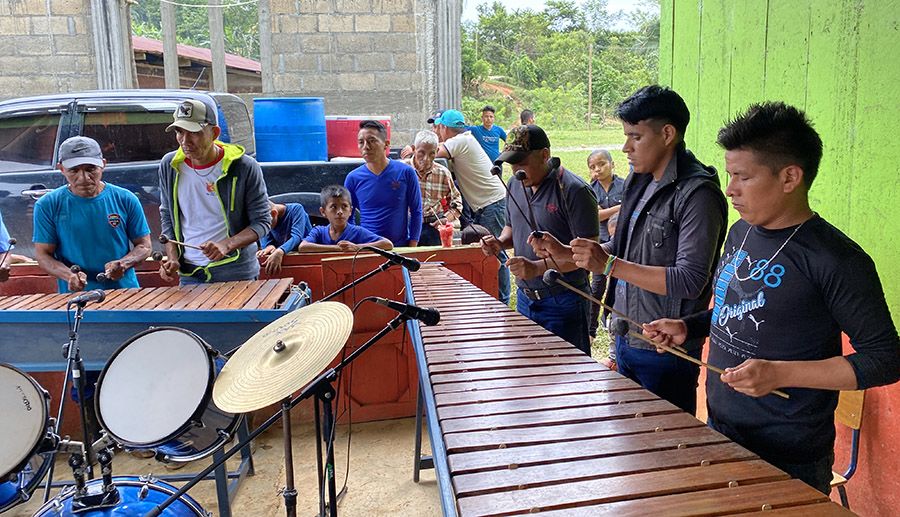
A marimba band was part of the entertainment, and Crockett, a musician during his off-hours, sat in on drums for one song. A highlight was the piñatas, with a horde of children eagerly clustering around to get candy as it spilled. The Americans left for good around 2 p.m., and although they wouldn’t miss the miles of bumpy road, they would remember how the people of Santa Isabel welcomed them into their town and their homes.
Getting Home the Long Way
Returning to the hotel in Playa Grande, the VMDAEC team anticipated spending one more night in hopes that they could get through to Cobán the following day. Then at 5:15 p.m. they received the word from translator Erick Berganza—the protesters had cleared the nearby bridge and the team needed to leave in 45 minutes. The workers scrambled to load the bags and then headed out, getting snacks at a convenience store to serve as dinner. After a couple of hours, the truck caravan got within 32 miles of the intended hotel in Cobán and then encountered another blockade, near the spot of the first one at the start of the mission. The drivers parked the trucks perpendicular to the road so they could be prepared to leave in either direction. There the team waited for almost two hours—in the dark—since a tree had taken out the power line in the area. The speeches and the shouting of the protesters could be heard in the distance. A few members attempted to get some sleep in the trucks, wondering if they would be stuck there until morning.
Crew chiefs and translators finally decided to bypass the blockade, going back to the intersection near Playa Grande and taking a different route for Guatemala City. The new route took the group far to the east, coming within less than a mile of the southwest corner of Belize, before turning southwest to head for the capital city. The detour was an overnight ride of eight additional hours on the road, stopping every so often to switch for fresh drivers. Several towns had gas stations that billed themselves as having 24-hour service but their stores were closed. Large trucks, many decorated in colorful lights, were almost the only other vehicles on the road.
Around 5:30 a.m. on October 18, police pulled over the caravan at a gas station in Teculután and checked the identification of some of the team members. By then, the light of the rising sun was visible over the mountains. The drive from there offered spectacular views of the mountains from both sides of the road. An hour later in San Esteban, still almost two hours from Guatemala City, the team stopped for breakfast at a very American establishment—McDonald’s. The only visible differences in the menu? The fried plantains available with breakfast and the McMuffin Chapín with refried beans as a topping. (Chapín is a nickname for Guatemalans.) The Americans said goodbye to Willy Alonso, who had ably handled translation duties during interviews with locals and during the celebration, and he was clearly emotional at having to leave after spending two weeks with the team.
Reaching Guatemala City at 9 a.m., the caravan checked into a Holiday Inn in an upscale area, which was much plusher than the Spartan accommodations in Playa Grande, with a beautiful view of the city and the mountains. From there, the Mid-Atlantic workers had two days of recreation before flying back to the United States. They enjoyed a visit to the old colonial capital Antigua Guatemala, dinner at the coffee farm Finca San Cayetano, shopping at the Mercado Central underground market, rides on electric scooters, and a final dinner together that featured excellent steaks. The level of wealth contrasted greatly with Playa Grande and especially with Santa Isabel, where villagers sleep in wooden beds with few mattresses and in ragged hammocks. Several members of the VMDAEC group had remarked on how happy the villagers were despite the harshness of life there. The line workers pulled together in difficult circumstances to help people far less fortunate, and through their labor and sweat, they were able to make a lasting difference in the lives of the residents of Santa Isabel.
